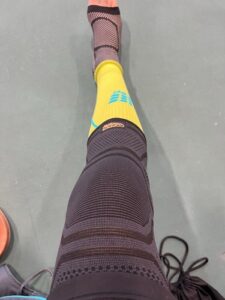 The fastest-growing sport in the United States also claims skyrocketing injuries. More than 67,000 twisted ankles, kinked backs, and broken wrists show up yearly in hospital emergency departments, courtesy of America’s sporting sweetheart: pickleball.
The fastest-growing sport in the United States also claims skyrocketing injuries. More than 67,000 twisted ankles, kinked backs, and broken wrists show up yearly in hospital emergency departments, courtesy of America’s sporting sweetheart: pickleball.
To add financial insult to the physical cost, CNN reports that pickleball injuries drain Americans more than 400 million dollars annually.
“The injuries range from lower disc problems, neck and muscle strains, to wrist fractures and achilles and rotator cuff tears,” says Dr. Colin Haines, a spine surgeon with VSI, located in the suburbs of the nation’s capital.
With a shrunken court, a lightweight paddle, and a ball that produces a shockingly loud hollow popping sound to the chagrin of communities all over the U.S., pickleball is a bit of a wolf in sheep’s clothing. It seems too easy.
“Whether it’s the fun name or the smaller court, I think many people are underestimating the physicality with this sport and quickly overdo it without realizing it,” says Haines.
It’s also popular with weekend warriors, and you’re more likely to get hurt if you’re not a regular exerciser. Fifty-four-year-old Chris Howell, a real estate agent in Virginia turned pickleballofile, found out the truth the hard way.
“All of the injuries were totally my fault,” says Howell, who confesses to being 100-percent addicted to the sport.
The first few weeks, Howell picked up the sport; he pulled the fascia in his left foot between his heel and toes and was out for a week. He resumed play, tearing a calf muscle, which sidelined him for three weeks. It’s not uncommon, says Howell, to hear of teammates with calf tears and tennis, er, pickleball elbow pain.
“I am not ashamed to admit that I have been known to play up to six hours of pickleball in one day,” says Howell. “I have a breakfast meeting, then I play. I skip lunch, work more, and then play. After dinner with my wife, I play until they kick me out at ten at night.”
Dr Haines spends a fair part of his practice educating patients about avoiding injury from various sports like basketball and football, pastimes like gardening, and even seasonal pain from shovelling snow and wrapping Christmas presents. VSI specializes in advanced spine care and solutions, sports medicine, and reducing full-body pain and injury through innovative, surgical, and non-operative solutions.
Haines recommends hydration, conditioning, and stretching before your first match to avoid injury in pickleball. All of those steps apply afterwards as well.
“The first time I played, I could barely walk the next day, and I play a lot of tennis,” says Haines, who plays both sports regularly and competitively.
“One common mistake, especially on the first outing, is people get excited and caught up in the fun, playing for many hours instead rather than a short introduction to get the body used to new movements.”
Dr. Haines has several tips for avoiding injury while playing pickleball:
- Equip Yourself: Make sure you have the right equipment. Running shoes can have a higher platform, perfect for twisting an ankle. A court shoe is better. Light paddles are unsuitable for beginners because you may swing too hard to generate power. Ensure the grip is the correct size so you don’t squeeze too hard and bend your wrist awkwardly.
- Stretch Everything: Most people focus on legs and hamstrings but don’t stop there. Stretch your lower and mid back with yoga stretches like cat and cow, and stretch your upper back.
- The 5-5-5 Rule: 5 minutes before you play, combine 5 minutes of stretching and walking, not just one or the other. Repeat for 5 minutes after the end of the game.
- Short Court: For the warm-up, start in the kitchen (near the net) with gentle volleying and dinks. Then, step back and do more complex shots.
- Feet Over Arms: Get to the ball with your feet, not your arms. Take multiple small steps so you don’t overextend with reach.
- Scooping Up: Watch how you pick up the ball. Injuries can happen after you’ve lost the shot! Try to pick up the ball with the paddle, pressing the ball against your foot and raising your leg to your hand rather than bending to the ground.
- Recover Fully: People often downplay or even ignore recovery. If you’re hurting, sit out the next day. Pay attention to your pain.
“And if your pain is really bad, accompanied by numbness or tingling, call someone like me,” suggests Haines.
Howell is back on the court, healthy and uninjured. He can’t help himself.
“I essentially play bubble-wrapped, with compression sleeves on my feet, ankles, calves, knees, and elbows.”
Stretching is a big part of his pre- and post-match routine. Drinking a Powerade before every game is crucial to his hydration regimen. Howell remains undaunted by the past injuries and extensive pickleball prep.
“I’m in the best shape I’ve been in decades. I lost 15 pounds and I am absolutely addicted to it. It has made me stronger physically and mentally. It’s worth it.”
Howell is not alone. Thirty-six million Americans are estimated to play pickleball, reflecting upwards of 200-percent growth in the sport in the last three years. In 2018, April became National Pickleball Month. Of course, Americans officially recognize many strange causes, like National Hug A Plumber Day and National Peanut Butter Lovers Month. The second Friday in January is National Quitters Day, but no one on a pickleball court knows about that.
Written By Kimberly Lohman Clapp


















Great info!! Thank you.